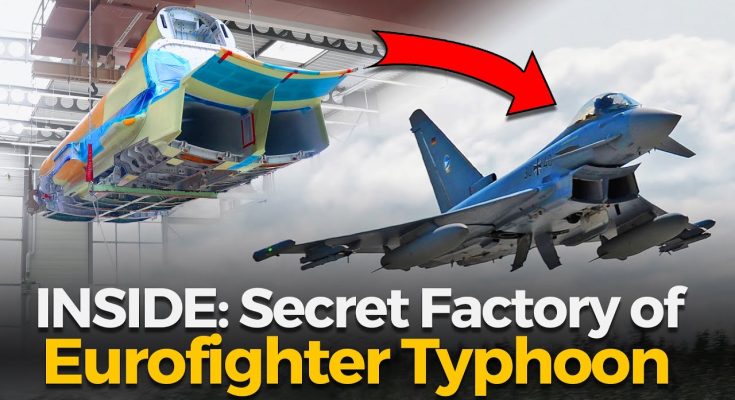The Eurofighter Typhoon is one of Europe’s most advanced and versatile multirole fighter jets, developed through a collaborative effort between multiple European countries. Designed to excel in air superiority, ground attack, and even reconnaissance missions, the Typhoon has become a cornerstone of many European air forces. Here’s a deep dive into how this remarkable aircraft is built, its unique features, and the cutting-edge technology that makes it one of the most advanced jets in the world.
Development and Design Origins
The Eurofighter Typhoon was developed as part of the European Fighter Aircraft (EFA) program, which began in the 1980s as a joint venture between the United Kingdom, Germany, Italy, and Spain. The primary goal was to create a next-generation, multirole combat aircraft that could match or exceed the capabilities of competitors like the F-16 Fighting Falcon and F/A-18 Hornet.
The Eurofighter consortium—comprising Airbus, BAE Systems, and Leonardo—came together to bring the Typhoon to life. The project faced numerous challenges over its decades-long development, from technical hurdles to political negotiations, but the result is one of the most sophisticated fighter jets ever created.
Key Features of the Eurofighter Typhoon
1. Multirole Capability
The Typhoon is designed to be a multirole aircraft, excelling in air-to-air combat while also possessing formidable ground-attack and reconnaissance abilities. It can carry a wide range of weapons, including air-to-air missiles, bombs, and precision-guided munitions for ground strikes. This versatility makes it highly adaptable to different mission profiles, including close air support, interception, and intelligence-gathering.
2. Supercruise Capability
The Eurofighter Typhoon is equipped with supercruise capability, meaning it can fly at supersonic speeds without engaging afterburners. This capability gives it a significant edge over rivals, as it can cover large distances at high speeds without consuming as much fuel as jets that require afterburners to reach supersonic speeds. Supercruise is a key feature for both strike missions and combat air patrols.
3. Stealth and Radar-Evasion
While not a true stealth fighter like the F-35, the Eurofighter Typhoon is designed with some low observability features to reduce its radar signature. Its airframe design minimizes radar cross-section, and the advanced avionics help it avoid detection by enemy radars. Its electronic warfare systems also provide a level of jamming and countermeasures, giving the Typhoon an edge in contested environments.
4. Cutting-Edge Avionics and Sensor Fusion
One of the most important features of the Typhoon is its advanced avionics system, which integrates a variety of sensors and radar systems. The captor radar is one of the standout technologies, offering both long-range tracking and multi-target capabilities. The sensor fusion system combines data from these different sensors into a single comprehensive picture, giving the pilot a complete view of the operational environment, even in the most chaotic airspace.
5. Advanced Cockpit
The cockpit of the Typhoon is designed for maximum pilot efficiency. It features dual-flight controls for both the pilot and the weapons systems officer, providing flexibility during operations. The cockpit also has digital glass displays that provide critical information like weapon status, radar targeting, and mission data. The cockpit is designed to allow for quick decision-making in high-pressure situations, with minimal distractions.
How the Eurofighter Typhoon is Built
Building the Eurofighter Typhoon is a complex and highly collaborative process that involves multiple countries and companies. The construction of each aircraft is spread across different sites in Europe, with each partner taking responsibility for certain parts of the design and manufacturing process.
1. Component Production
- Airbus is primarily responsible for the fuselage and wings, while also assembling the aircraft.
- BAE Systems handles the aircraft’s front section, including the cockpit, and is also responsible for the flight control systems.
- Leonardo is in charge of the radar systems and avionics, ensuring that the aircraft has the most advanced sensors and communication tools.
2. Final Assembly
The final assembly of the Eurofighter Typhoon takes place at Airbus’s facilities in Germany and the United Kingdom. Once all the components—such as the fuselage, wings, avionics, and propulsion systems—are delivered to these plants, they are assembled into the finished aircraft. The aircraft undergoes rigorous testing and quality control checks at each stage of production to ensure every part meets the high standards required for combat operations.
3. Testing and Evaluation
After assembly, the Eurofighter Typhoon undergoes a series of extensive flight tests. These tests evaluate everything from flight performance to weapon systems functionality and stealth capabilities. The aircraft must pass through various military specifications before it can be delivered to the respective air forces.
Role in Modern Air Forces
The Eurofighter Typhoon has been adopted by several European nations, including the UK, Germany, Italy, Spain, and Austria, as well as by Saudi Arabia and Oman. It has played a significant role in NATO operations and is often called upon for air policing missions in contested airspaces.
The Typhoon has proven itself in numerous operations, including combat and peacekeeping missions. Its versatility and advanced capabilities make it a vital asset to European defense.
Conclusion
The Eurofighter Typhoon is the culmination of European ingenuity and collaboration, creating an advanced fighter jet that blends cutting-edge stealth, maneuverability, and multirole capabilities. From its supercruise ability to its sensor fusion technology, the Typhoon stands out as one of the most capable fighters in the world today. Its construction is a complex, multi-country effort that involves highly advanced manufacturing techniques and rigorous testing to ensure it meets the demands of modern combat.



